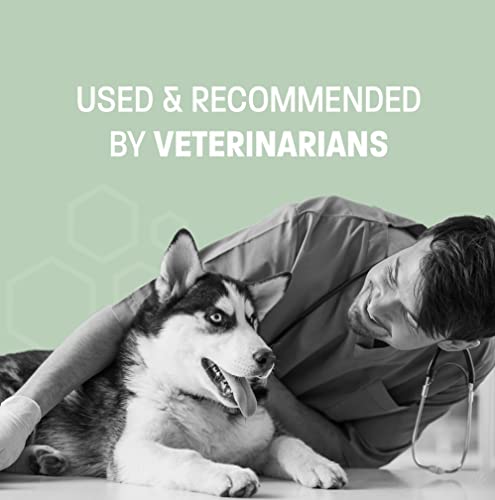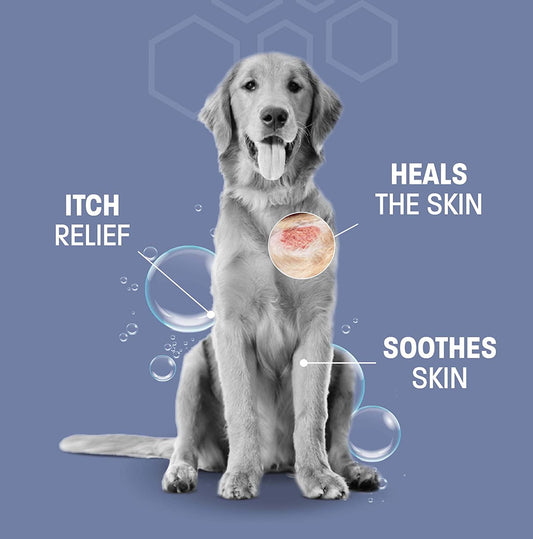Addressing dog ear yeast infections requires a multifaceted approach. Pet Health Pros details various treatments and showcases how our specialized medicated products fit into the regimen.
Dog ear yeast infections can be a real nuisance for our four-legged pals. Yeast is the type of fungus which causes these infections and loves warm and moist areas, like dogs' ears and paws. Treating this infection is essential to give your pup relief and avoid more serious problems. In this guide, we'll look at different ways to effectively treat dog ear yeast infections.
Comprehending the causes and symptoms of dog ear yeast infections is the first step. Allergies, hormonal imbalances, or too much moisture in the ears can bring on these infections. Common signs include itching, redness, discharge, bad smell, and head shaking. If you spot them, it's essential to consult a vet for a proper diagnosis.
One way to treat dog ear yeast infections is with antifungal medications. Your vet could prescribe ointments or creams which contain miconazole or clotrimazole. These meds target and eliminate the fungal overgrowth, providing relief from itching and inflammation.
Keeping your pup's ears clean and dry is another key factor. Check regularly for any signs of infection or moisture. Clean the area with a vet-approved cleaning solution to remove debris and preserve hygiene. Make sure your dog's ears get enough air by trimming excess fur.
Dietary modifications are also helpful. Some vets recommend adding probiotics to your dog's diet to keep a healthy balance of bacteria, preventing yeast infections. You can find probiotics in yogurt or pet supplements.
Understanding Dog Ear Yeast Infections
To understand dog ear yeast infections, delve into the sub-sections: What is a yeast infection?, Causes of ear yeast infections in dogs, and Symptoms of a dog ear yeast infection. These will provide you with a comprehensive understanding of the issue and the necessary steps to address it effectively.
What is a yeast infection?
Yeast infections in dogs are caused by an overgrowth of the fungus Candida. Long-eared dogs and those that swim often are more at risk. Symptoms include scratching, shaking heads, redness, odour, and discharge. Treatment consists of cleaning the ears and medication. To avoid recurrence, underlying causes such as allergies or hormone imbalances must be addressed.
Untreated ear yeast infections can lead to other issues like chronic inflammation and bacterial infections. So, early diagnosis and treatment are essential.
Causes of ear yeast infections in dogs
Yeast infections in dogs' ears can be caused by many things.
- Allergies can be a big factor.
- Too much wetness in the ear canal can lead to yeast growth.
- Health problems which weaken the immune system can make the pup more likely to get an infection. Poor hygiene and no regular cleaning can also contribute.
It's important to find and tackle the cause of the infection. Allergies can be managed by steering clear of allergens or taking meds from the vet. Keeping your dog's ears dry after bath time can help with moisture. Grooming and cleaning should be done regularly to keep the ears healthy.
Symptoms of a dog ear yeast infection
Is your pup suffering from a dog ear yeast infection? Look out for these symptoms as red flags:
- Excessive scratching and head shaking.
- Foul-smelling discharge or wax buildup in the ears.
- Redness and swelling on inner ear surfaces or around the ear canal.
- Rubbing ears against furniture or pawing them.
Other not-so-common signs are scabs or crusts on outer ear, hair loss, and changes in behavior (e.g. irritability). If you observe any of these, consult a vet immediately.
Delaying treatment can lead to further complications. Your vet may prescribe antifungal solutions or antibiotics to get rid of the yeast and reduce symptoms. Provide relief and comfort for your beloved pup - don't wait - see the vet today.
Diagnosing Dog Ear Yeast Infections
To diagnose dog ear yeast infections, turn to veterinary examination and diagnostic tests. A thorough examination by a veterinarian will help determine the presence of a yeast infection in your dog's ears. Diagnostic tests specifically designed for ear yeast infections further aid in confirming the diagnosis and identifying the appropriate treatment for your furry friend.
Veterinary examination
It is necessary to get a vet check-up when trying to identify a dog's ear yeast infection. The vet will view the dog's ears for signs such as redness, puffiness, gunk, and smell. They may also use an otoscope to inspect the ear canal and get a sample for lab testing.
The vet can ask questions about the pup's medical history and any past ear issues. This info helps to cross out other possibilities of ear discomfort or infection. Additional tests, like cytology analysis or culture and sensitivity tests, may be done to verify the presence of yeast and decide the best treatment.
It's essential to remember that only a vet can accurately diagnose and treat a dog's ear yeast infection. Over-the-counter products may not work for all cases. They can even worsen the condition if used the wrong way. Always get professional help before trying anything.
Pro Tip: Cleaning the dog's ears using a vet-approved solution on a regular basis can help prevent yeast infections and keep the ears healthy.
Diagnostic tests for ear yeast infections
Vets rely on visuals and lab tests to diagnose ear yeast infections in dogs. They use an otoscope to check the ears for signs like redness, swelling, or discharge. This gives clues, but isn't enough.
So, they take a sample of the discharge and look at it under a microscope. This lets them spot yeast cells and blastospores, which confirms an infection.
In some cases, more tests are needed. Culture tests involve growing the specific type of yeast in a lab. This helps with targeted treatment.
It's important to detect and diagnose these infections quickly. If not treated, they can lead to discomfort, pain, and even more serious issues. Don't delay - get veterinary care right away!
Treating Dog Ear Yeast Infections
To effectively treat dog ear yeast infections and alleviate the discomfort they cause, follow these steps: Clean the ears, use over-the-counter antifungal treatments, consider prescription medications, and explore home remedies. Cleaning the ears removes excess buildup, while antifungal treatments target the yeast. Prescription medications provide stronger solutions, and home remedies offer a natural approach to treating these infections.
Cleaning the ears
Start inspecting your pup's ear flaps! Look for any redness, swelling, discharge, or bad smells. Be sure to examine every part.
Saturate a cotton ball with a vet-recommended cleansing solution and wipe the inside. Don't use cotton swabs or insert anything into the ear canal.
Dry off excess moisture by using a cotton ball. This will help stop yeast from growing. Make sure it's completely dry before doing anything else.
Getting a professional clean done is necessary if the infection is severe or ongoing. Your vet can also advise a tailored treatment plan just for your dog.
Over-the-counter antifungal treatments
Antifungal creams, wipes, ear drops, and natural remedies can be used to combat yeast infections in your dog's ears. Follow instructions closely and consult with a vet before use. To avoid recurrence, tackle underlying causes such as allergies and moisture.
One dog owner found success through consistent use of over-the-counter treatments and lifestyle changes. With the help of a vet, they achieved comfort and happiness for their pet. Over-the-counter antifungal treatments, with professional guidance, can help your canine overcome this condition.
Prescription medications for yeast infections
Prescription meds are essential for treating dog ear yeast infections. They are designed to target the cause and bring relief. Here are the main points to remember:
- Antifungal drugs are often prescribed.
- These drugs stop the growth and spread of yeast.
- Clotrimazole is a popular medication, available in drops or creams.
- Ketoconazole is another strong antifungal.
- Always follow the dosage and treatment length your vet prescribes.
It's important to use prescription medications under a vet's professional guidance. They have the expertise to choose the best meds for your dog's condition. Follow their advice for the best results.
Home remedies for treating dog ear yeast infections
Treating dog ear yeast infections? We've got you covered! Try these five home remedies:
- Apple cider vinegar
- Coconut oil
- Probiotics
- Neem oil
- Gentian violet
But, make sure to only use them in mild cases. And keep your pup's ears clean and dry!
History shows us that these natural ingredients have been used for centuries to help our furry friends. Ancient civilizations found relief in apple cider vinegar and coconut oil. So, use these tried-and-true methods to help your pet without relying solely on synthetic meds.
Don't worry if your pup has an ear yeast infection. Turn to nature's pantry and give them the relief they deserve.
Preventing Dog Ear Yeast Infections
To prevent dog ear yeast infections, maintain a regular ear cleaning routine, consider dietary adjustments, and reduce allergens in your pet's environment. These sub-sections highlight the practical solutions for keeping your dog's ears healthy and free from the discomfort caused by yeast infections. Get ready to equip yourself with the knowledge to safeguard your furry friend's well-being.
Regular ear cleaning routine
Regular ear cleaning for pups is essential to avoid yeast infections! Here's a 5-step guide to make it easier:
- Get the supplies your vet recommends - a gentle cleaning solution and cotton balls or gauze.
- Find a nice, quiet spot and make sure your pup is relaxed.
- Inspect their ears for redness, swelling, discharge, or smell. If you find anything, consult your vet.
- Gently wipe the visible part of your dog's ear canal with the cleaning solution. Don't go deep in the canal.
- Do the same for the other ear. Give your pup praise and treats!
Certain breeds like Cocker Spaniels, Basset Hounds, and Golden Retrievers have an increased risk of ear infections due to their floppy ears and trapped moisture.
Regular ear cleaning is key to help protect our furry friends from discomfort. Always check with your vet for tailored advice.
Dietary considerations for preventing yeast infections
Dietary changes are key to reducing the risk of dog ear yeast infections. Pet owners should make slight modifications to their pup's diet, such as:
- Eating probiotic-rich foods like yogurt and kefir.
- Opting for low-carbohydrate options.
- Incorporating anti-inflammatory ingredients like turmeric, ginger, and green leafy veggies.
- Adding sources of omega-3 fatty acids, like salmon or fish oil supplements.
- Limiting sugar intake and opting for low-sugar or sugar-free alternatives when choosing treats.
- Avoiding allergenic ingredients such as wheat, corn, and soy.
In addition, regularly clean your pup's ears using vet-approved solutions to remove any debris or moisture.
Interestingly, ancient recipes for pet food often included natural ingredients such as bone broth and organ meats. This ancestral diet could help prevent health issues, including yeast infections. So, maybe we should look back at our roots to keep our furry friends healthy!
Reducing allergens and maintaining a clean environment
Regularly clean your pup's ears with a vet-approved solution to get rid of dirt, debris and excess wax. These can contribute to yeast overgrowth. Minimise exposure to allergens like pollen, dust mites and mould by keeping your home clean.
Brushing your dog regularly helps remove dead skin cells and stop matting, which can trap moisture and promote yeast growth.
For a clean environment, wash your dog's bedding often and avoid exposure to cigarette smoke or harsh chemicals.
One pet owner said that following these steps helped their dog beat chronic ear infections. With regular cleaning and reduced allergen exposure both inside and out, their pet experienced improved ear health.
Be sure to prioritize cleanliness and allergen control measures for your pet. This will help prevent ear yeast infections and give them a healthier, more comfortable life.
When to Seek Veterinary Help
To address persistent or recurring yeast infections in your dog's ears or paws, as well as severe or complicated cases, it may be necessary to seek veterinary help. Your dog's health and well-being are of utmost importance, so be proactive in recognizing when professional intervention is required.
Persistent or recurring yeast infections
Yeast infections happen when yeast overgrows on your pet's skin or in their ears. It can be brought about by allergies, hormone problems, or a weak immune system. If untreated, it can cause distress and even more serious problems.
If your pet gets the same or recurring yeast infections, speak to a vet. They will diagnose it and create the best plan for treating it. This can include creams/ointments, oral meds, or changes in diet/hygiene.
In order to prevent these infections from happening again, look for what might be causing them. Try to find and remove allergens from your pet's environment, treat underlying health issues, or change their diet.
To avoid yeast infections, keep your pet's skin clean and dry, especially in areas with lots of moisture. This could be between their paw pads or skin folds.
Severe or complicated cases
In these cases, it's essential to find veterinary help quickly. Delaying medical care can make the pet's condition worse and even lead to irreversible damage. Vets have vast knowledge and experience, so they can assess how serious the situation is, give proper treatment, and make sure the pet has the best outcome.
Plus, severe or complex issues often require unique equipment and facilities found in vet clinics or hospitals. These resources let vets do thorough tests, do intricate procedures, and watch the patient's progress closely. With these services, pet owners can be sure their furry friends are getting the best care.
Pro Tip: If your pet has severe or complex issues, get help from a vet right away. Their pro knowledge and special tools can make a huge difference in your pet's recovery.
Conclusion
With comprehensive knowledge and the right products from Pet Health Pros, overcoming dog ear yeast infections becomes a feasible task.
Treating dog ear yeast infections needs a professional and expert approach. So, let's look at the thoughts on this guide.
We have seen: yeast infections in dogs are caused by too much fungus. To tackle this, antifungal treatments help both in ears and paws. Following a plan can ease the pet's discomfort and stop future problems.
We must also think of unique details. Natural remedies such as apple cider vinegar or probiotics can help balance the ears' microbiome.
Frequently Asked Questions
Q: What causes a dog to develop a yeast infection in their ears?
A: Yeast infections in dog ears are often caused by the overgrowth of a fungus called Malassezia. Factors such as allergies, moisture buildup, improper ear cleaning, or a weakened immune system can contribute to its development.
Q: How can I tell if my dog has a yeast infection in their ears?
A: Common signs of a dog ear yeast infection include constant scratching or rubbing of the ears, redness and swelling, a strong odor, discharge, or thickening of the ear canal's skin. If you notice these symptoms, it is best to consult a veterinarian for a proper diagnosis.
Q: Can I treat my dog's ear yeast infection at home?
A: While some mild cases may improve with home remedies, it is recommended to seek veterinary advice for proper diagnosis and treatment. A vet will be able to determine the severity of the infection and prescribe appropriate antifungal medications.
Q: Are there any preventive measures I can take to avoid ear yeast infections in my dog?
A: Regular cleaning of your dog's ears using an appropriate ear cleaner can help prevent yeast infections. It is also important to keep your dog's ears dry, especially after bathing or swimming, and address any underlying allergies or immune system issues they may have.
Q: Can a dog's paws also get yeast infections?
A: Yes, dogs can develop yeast infections on their paws. Excessive licking or chewing of the paws, redness, swelling, and a foul odor are common signs. Proper veterinary diagnosis and treatment are necessary for resolving paw yeast infections.
Q: How long does it take to treat a dog's ear yeast infection?
A: The duration of treatment can vary depending on the severity of the infection and the recommended medication. Mild cases may resolve in a couple of weeks, while more severe infections can take several weeks to fully clear up. It is crucial to follow the vet's instructions and complete the entire course of treatment.








